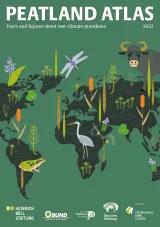
Mires are intact peatlands and home to rare plants, rare animals – and enormous amounts of carbon. But draining them for economic reasons puts them and their resident organisms at massive risk. It poses a massive threat to the climate too.

Mires have long shaped many landscapes around the world. They are fascinating ecosystems, whose development is inseparable from the presence of water. This comes either solely from rainwater or additionally also from groundwater. Unlike as in a lake, this water does not fill a depression in the ground, but it fills pores in the soil. The high water level excludes air from the soil. As a result, dead plant material does not decompose completely, and peat forms, by perhaps a millimetre a year.
One thing that all peatlands – both the natural, undrained mires and also drained peatlands – have in common is that they are long-term and very space-efficient carbon stores. To put that in numbers: peatlands cover just 3 percent of the Earth’s land surface, but they harbour around twice the amount of carbon as the biomass in all of the planet’s forests. Worldwide, they store 600 billion tonnes of carbon. But peatlands nearly everywhere around the world are threatened by human activities.
The two main mire types are distinguished based on their water supply. Bogs are fed only by rainwater. They are poor in nutrients, more acidic and with water tables higher than in their surroundings. Fens, on the other hand, depend on groundwater, spring water or seepage. They are more rich in nutrients and less acidic compared to bogs. The majority of peatlands in Europe are fens.
Mires have also an enormous significance for biodiversity. They provide unique habitats for rare animals and rare plants that are adapted to a wet environment. They are often the last refuges for many rare and threatened species, such as the aquatic warbler, shoebill or orangutan. Many mires are typified by their extent, their openness, and many open water bodies they contain. They offer waders and waterfowl numerous opportunities for rest and overwintering. Not only that: mires improve the quality of water by filtering out pollutants it contains.
Plant genera such as peat mosses occur throughout the world, and numerous species exist that are large, sturdy and colourful, all of which can form peat. Mires in the boreal and temperate regions are often open landscapes with moss and grassy vegetation and relatively few trees. Tropical mires, on the other hand, are often covered with forest. These peat swamp forests are impenetrable areas that are home to species such as lowland gorillas, forest elephants, chimpanzees, bonobos and the Allen's swamp monkey.
Humankind has used peatlands for thousands of years. Nowadays these lands are used mainly for farming, forestry and peat extraction. As largely applied today, these forms of use require the peatland to be drained. But water is necessary for mires: take it away, and the environment changes dramatically. Oxygen penetrates into the soil, the peat decomposes, and the greenhouse gas carbon dioxide (CO₂) is released – turning the mire into a drained peatland and a climate problem. Drainage also deprives the typical mire species of their habitat.
Europe is the continent that has so far lost the most natural peatlands. Some 10 percent of its erstwhile peat cover has been lost through drainage. Of the remaining peatland area – around 100 million hectares – one-quarter is degraded or damaged. Within the European Union, the figure is one-half.
Drained peatlands are responsible for around 5 percent of all greenhouse gas emissions in the European Union. Drained peatlands no longer act as a carbon sink, but also release greenhouse gases into the atmosphere. This disastrous role becomes even clearer if we look at the emissions from farming, 25 percent of which are caused by drained peatlands. And that is even though peatlands cover just 3 percent of the agricultural area. That is why drained peatlands are one of the major fields of action for climate protection in agriculture and land use.
The central role of water in the functioning of peatlands makes them particularly vulnerable to disturbances. Besides drainage, other threats facing peatlands include road construction, reservoir creation, oil-sands mining, overgrazing and pollution. Europe is a global peatland degradation hotspot because of widespread land-use changes for agriculture, forestry and peat extraction. Next to Europe, major hotspots are Northeastern China, Southeast Asia and the American Midwest. The degree of drainage directly affects the amounts of greenhouse gas emissions released annually from degraded peatlands.
According to numerous studies, some of the damage to peatlands caused by drainage cannot be repaired; the landscape is permanently changed. That makes it all the more important to stop peatland drainage before it is too late, and to protect mires and peatlands, because if dried-out areas are rewetted, the release of carbon dioxide can be stopped. Such rewetting is one of the central tasks for the present and future.
A comprehensive protection of peatlands can succeed if peatland conservation and land use are brought into harmony. Instead of a total stop to the use of peatlands, what is needed is a range of new, wet ways of managing the land, ranging from wet wilderness to high-intensity paludiculture. That is why technical specialists and environmental groups call on policymakers to provide more support for such socio-ecological transformation through a combination of incentives and regulation.

